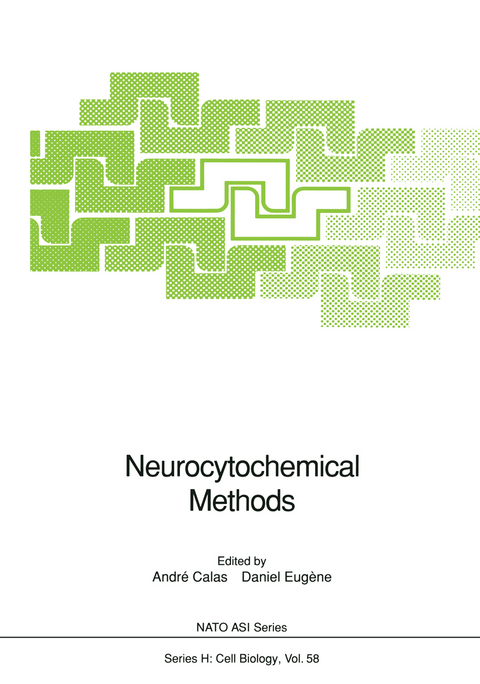
Neurocytochemical Methods
Springer Berlin (Verlag)
978-3-642-84300-6 (ISBN)
The great strides made in the field of morphological methods during the past decades have perhaps found their most spectacular expression in the functional exploration of the nervous system. In comparison with other tissues, nerve tissue displays three kinds of specificity : structural, because of the unique organization of the neuronal networks ; chemical as shown, for example, by the informative molecules exchanged between the nerve cells, and of course functional, thanks to the particular metabolic and electrophysiological characteristics of the neurons. Although for a long time the structural properties of the nervous system were generally considered to constitute the only field to which morphological techniques could be applied, we are to-day justified in believing that they can also explore the nerve tissue through its specific chemical and functional aspects, thanks to the development of immunocytochemistry and in situ hybridization, to the elaboration of the deoxyglucose method, to the use of voltage or ion sensitive dyes, and to the progress made in the application of in vivo techniques like PET. These methods have evolved so fast, the technical and fundamental problems they raise are so numerous and stimulating, and the importance of the complementary data they provide is so obvious, that we thought it was a good time to organize a new meeting between distinguished specialists in the neurocytochemical field.
Development and application of antibodies to primary (DA, L-DOPA) and secondary (cGMP) messengers: A technical report.- Hodology.- Transmitter-related retrograde labeling and immunohistochemistry to localize amino acid transmitters in neural pathways and cells.- Ultrastructural identification and quantification of neuroactive amino acids.- Video-microscopic techniques to study axonal transport, neuronal fine structure and cytochemical parameters in live neurons.- Investigating the three-dimensional morphology of fluorescence-labelled neurons using confocal laser scanning microscopy.- Chairman's report.- Detection of Specific Molecules.- Combined cytolabeling methods for investigating chemo-specific neuronal interactions and transmitter co-localization.- Molecular neuroanatomy of synapses, cells and systems in the brain.- Regulated expression of transcription factor and neurotransmitter genes in neural populations: studies using in situ hybridization with radiolabeled oligonucleotide probes.- The use of markers to study the regulation of glial cells in the PNS and CNS.- Chairlady's report.- Quantitative Aspects.- Applications to the study of acetylcholine release of the choline oxidase acetylcholine assay.- Morphometric evaluation of populations of neuronal profiles in the central nervous system.- Positron emission tomography: functional neuroanatomy in vivo.- Microfluorometric imaging of time and space dependent calcium concentration changes in mammalian neurons.- Chairman's report.- Receptors.- Immunocytochemistry of neuropeptide receptors using anti-idiotypic antibodies and antibodies to peptides encoded by complementary RNA.- New approaches for receptor analysis: histochemistry of the GABA/BZ receptors in the rat CNS.- Chairman's report.- Short Papers.-Extracellular dyes induce photodegeneration and photopermeabilization of vertebrate and invertebrate neurons.- A method to study projections of GABAergic neurons using deletion of the GABA immunostaining by metallic ions.- Ultrastructural immunocytochemical localization of choline acetyltransferase in sympathetic ganglia.- A dual immunoperoxidase labelling method to study the ultrastructural relationships between choline acetyltransferase- and neuropeptide Y-containing neurons in the rat striatum.- Characterization of microglia and brain macrophages.- Visualization and quantification of 5-HT1A receptors in the rat brain by radioimmunohistochemistry.- Anti-idiotypic antibodies against opioid receptors: first ultrastructural evidence for a presynaptic inhibition by opioids in the dorsal horn of the rat spinal cord.- Antibodies to complementary peptide for labelling substance P receptors in the dorsal horn of the rat spinal cord for both light and electron microscopy.- Comparative ultrastructural localization of neuropeptide mRNAs using tritiated and biotinylated oligodeoxynucleotide probes.- Use of in situ hybridization and immunohistochemistry to study the effects of intranigral injections of colchicine on enkephalin- and substance P-containing neurons of the limbic forebrain.- Chairman's report.- Author Index.
| Erscheint lt. Verlag | 19.1.2012 |
|---|---|
| Reihe/Serie | Nato ASI Subseries H: |
| Zusatzinfo | XVI, 335 p. |
| Verlagsort | Berlin |
| Sprache | englisch |
| Maße | 170 x 242 mm |
| Gewicht | 615 g |
| Themenwelt | Studium ► 1. Studienabschnitt (Vorklinik) ► Physiologie |
| Naturwissenschaften ► Biologie ► Humanbiologie | |
| Naturwissenschaften ► Biologie ► Zellbiologie | |
| Schlagworte | anatomy • brain • forebrain • Immunchemie • Immunocytochemistry • Morphology • Nerven • nervous system • Neuroanatomy • Neurochemie • neurochemistry • neurons • Neuropeptides • Neurotransmitter • PET • positron emission tomography (PET) • Rezeptor • spinal cord • tissue • transcription |
| ISBN-10 | 3-642-84300-X / 364284300X |
| ISBN-13 | 978-3-642-84300-6 / 9783642843006 |
| Zustand | Neuware |
| Haben Sie eine Frage zum Produkt? |
aus dem Bereich


